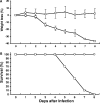Severe acute respiratory syndrome coronavirus infection of mice transgenic for the human Angiotensin-converting enzyme 2 virus receptor
- PMID: 17108019
- PMCID: PMC1797529
- DOI: 10.1128/JVI.01702-06
Severe acute respiratory syndrome coronavirus infection of mice transgenic for the human Angiotensin-converting enzyme 2 virus receptor
Abstract
Animal models for severe acute respiratory syndrome (SARS) coronavirus infection of humans are needed to elucidate SARS pathogenesis and develop vaccines and antivirals. We developed transgenic mice expressing human angiotensin-converting enzyme 2, a functional receptor for the virus, under the regulation of a global promoter. A transgenic lineage, designated AC70, was among the best characterized against SARS coronavirus infection, showing weight loss and other clinical manifestations before reaching 100% mortality within 8 days after intranasal infection. High virus titers were detected in the lungs and brains of transgene-positive (Tg+) mice on days 1 and 3 after infection. Inflammatory mediators were also detected in these tissues, coinciding with high levels of virus replication. Lower virus titers were also detected in other tissues, including blood. In contrast, infected transgene-negative (Tg-) mice survived without showing any clinical illness. Pathologic examination suggests that the extensive involvement of the central nervous system likely contributed to the death of Tg+ mice, even though viral pneumonia was present. Preliminary studies with mice of a second lineage, AC63, in which the transgene expression was considerably less abundant than that in the AC70 line, revealed that virus replication was largely restricted to the lungs but not the brain. Importantly, despite significant weight loss, infected Tg+ AC63 mice eventually recovered from the illness without any mortality. The severity of the disease that developed in these transgenic mice--AC70 in particular--makes these mouse models valuable not only for evaluating the efficacy of antivirals and vaccines, but also for studying SARS coronavirus pathogenesis.
Figures








References
-
- Ding, Y., L. He, Q. Zhang, Z. Huang, X. Che, J. Hou, H. Wang, H. Shen, L. Qiu, Z. Li, J. Geng, J. Cai, H. Han, X. Li, W. Kang, D. Weng, P. Liang, and S. Jiang. 2004. Organ distribution of severe acute respiratory syndrome (SARS) associated coronavirus (SARS-CoV) in SARS patients: implications for pathogenesis and virus transmission pathways. J. Pathol. 203:622-630. - PMC - PubMed
Publication types
MeSH terms
Substances
Grants and funding
LinkOut - more resources
Full Text Sources
Other Literature Sources
Molecular Biology Databases
Miscellaneous

